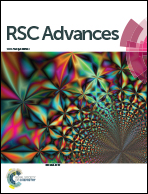Graphene induced microstructural changes of PLA/MWCNT biodegradable nanocomposites: rheological, morphological, thermal and electrical properties
Abstract
Two types of carbon nanofillers, i.e. multiwalled carbon nanotubes (MWCNTs) and graphene nanoplatelets (GnPs), were chemically functionalized and incorporated into poly(lactic acid) (PLA) through solution mixing to prepare single filler and hybrid PLA nanocomposites. The functionalization of the nanofillers was characterized in detail using FTIR and TGA analysis. X-ray diffraction (XRD) showed that functionalized GnPs (fGnPs) were fully exfoliated in the nanocomposites. The dispersion state of the single and hybrid nanofillers in the polymer matrix was studied in detail by means of melt viscoelastic experiments together with electron microscopy results, which revealed full exfoliation of fGnPs and high dispersion of fCNTs. It was shown that the incorporation of fCNTs–fGnP hybrids into PLA created a large surface area which established strong interfacial adhesion between the efficient hybrid nanofiller networks and the matrix. Positive deviation was observed from the mixture law in the electrical, thermal and mechanical properties. Thorough analysis of the results showed that formation of efficient hybrid networks enhanced the mechanical properties of hybrid filler nanocomposites through increasing effective stress transfer, retardation of flaw formation, emerging microcrack growth and dissipation of additional mechanical energy.


 Please wait while we load your content...
Please wait while we load your content...